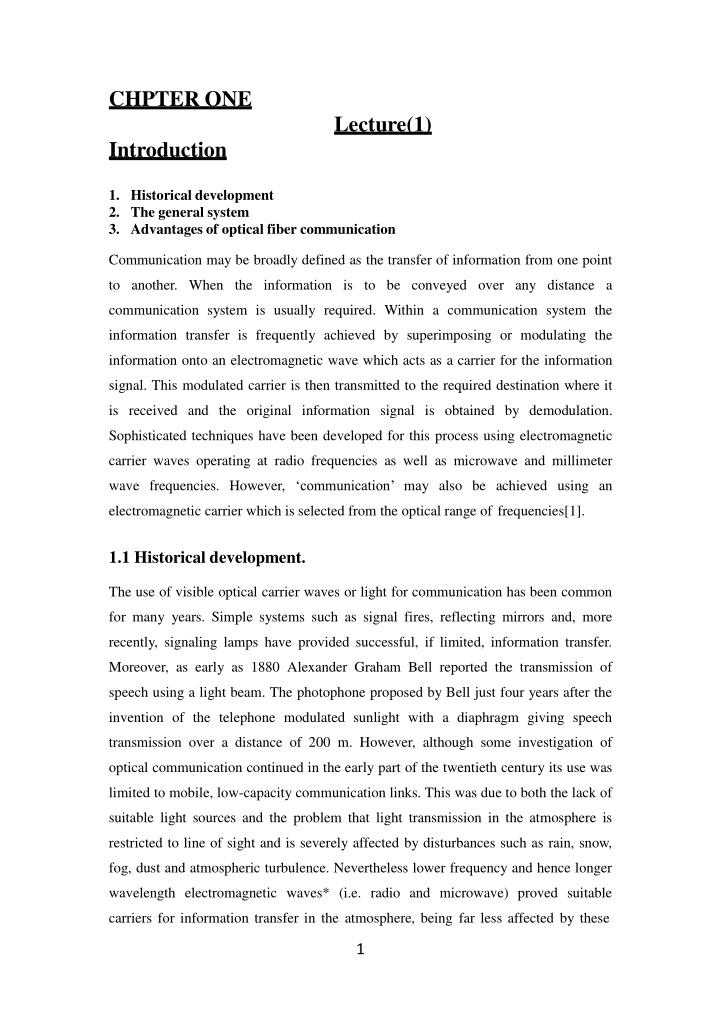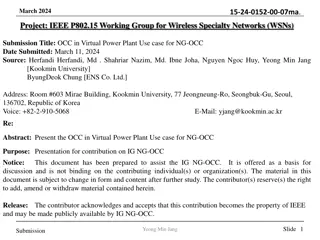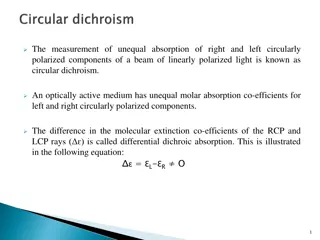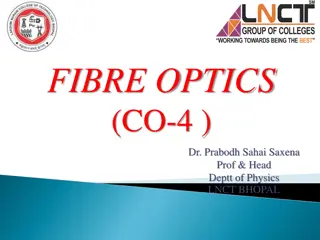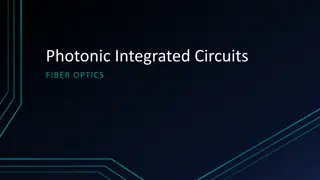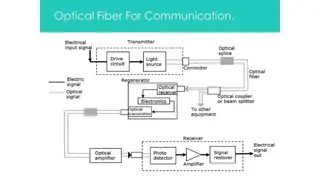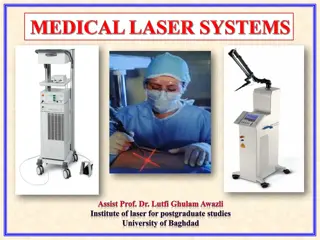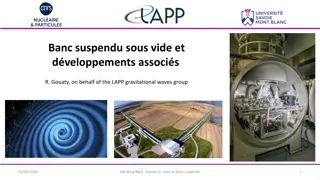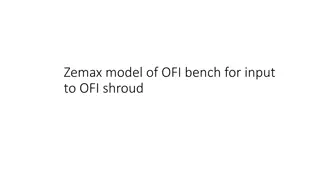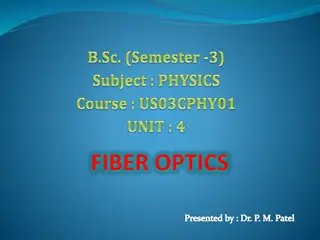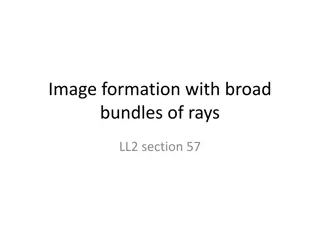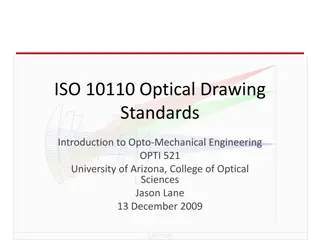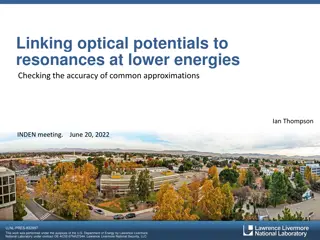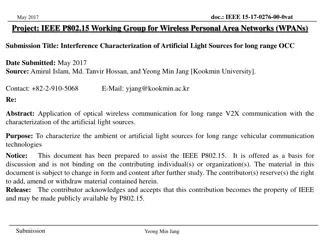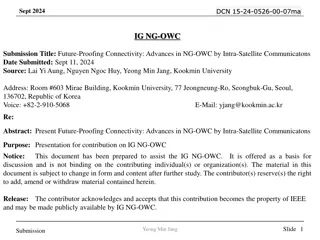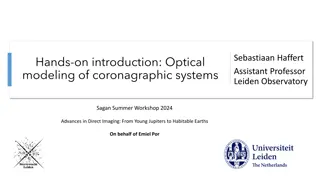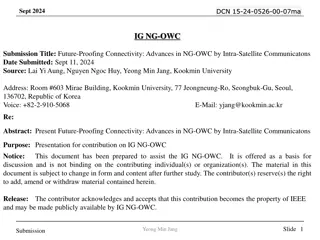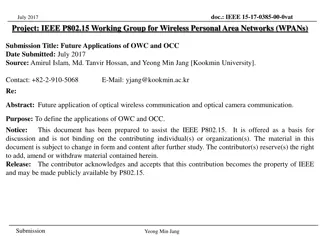Historical Development of Optical Communication Systems
Optical communication has a rich historical background, starting from the use of visible light waves for information transfer to the introduction of lasers in the 1960s. Despite challenges like atmospheric limitations, advancements in optical communication have led to improved data transmission capabilities and applications in various fields.
Download Presentation

Please find below an Image/Link to download the presentation.
The content on the website is provided AS IS for your information and personal use only. It may not be sold, licensed, or shared on other websites without obtaining consent from the author.If you encounter any issues during the download, it is possible that the publisher has removed the file from their server.
You are allowed to download the files provided on this website for personal or commercial use, subject to the condition that they are used lawfully. All files are the property of their respective owners.
The content on the website is provided AS IS for your information and personal use only. It may not be sold, licensed, or shared on other websites without obtaining consent from the author.
E N D
Presentation Transcript
CHPTER ONE Lecture(1) Introduction 1. Historical development 2. The general system 3. Advantages of optical fiber communication Communication may be broadly defined as the transfer of information from one point to another. When the information is to be conveyed over any distance a communication system is usually required. Within a communication system the information transfer is frequently achieved by superimposing or modulating the information onto an electromagnetic wave which acts as a carrier for the information signal. This modulated carrier is then transmitted to the required destination where it is received and the original information signal is obtained by demodulation. Sophisticated techniques have been developed for this process using electromagnetic carrier waves operating at radio frequencies as well as microwave and millimeter wave frequencies. However, communication may also be achieved using an electromagnetic carrier which is selected from the optical range of frequencies[1]. 1.1 Historical development. The use of visible optical carrier waves or light for communication has been common for many years. Simple systems such as signal fires, reflecting mirrors and, more recently, signaling lamps have provided successful, if limited, information transfer. Moreover, as early as 1880 Alexander Graham Bell reported the transmission of speech using a light beam. The photophone proposed by Bell just four years after the invention of the telephone modulated sunlight with a diaphragm giving speech transmission over a distance of 200 m. However, although some investigation of optical communication continued in the early part of the twentieth century its use was limited to mobile, low-capacity communication links. This was due to both the lack of suitable light sources and the problem that light transmission in the atmosphere is restricted to line of sight and is severely affected by disturbances such as rain, snow, fog, dust and atmospheric turbulence. Nevertheless lower frequency and hence longer wavelength electromagnetic waves* (i.e. radio and microwave) proved suitable carriers for information transfer in the atmosphere, being far less affected by these 1
atmospheric conditions. Depending on their wavelengths, these electromagnetic carriers can be transmitted over considerable distances but are limited in the amount of information they can convey by their frequencies (i.e. the information-carrying capacity is directly related to the bandwidth or frequency extent of the modulated carrier, which is generally limited to a fixed fraction of the carrier frequency)[1]. In theory, the greater the carrier frequency, the larger the available transmission bandwidth and thus the information-carrying capacity of the communication system. For this reason radio communication was developed to higher frequencies (i.e. VHF and UHF) leading to the introduction of the even higher frequency microwave and, latterly, millimeter wave transmission. The relative frequencies and wavelengths of these types of electromagnetic wave can be observed from the electromagnetic spectrum shown in Figure 1.1. In this context it may also be noted that communication at optical frequencies offers an increase in the potential usable bandwidth by a factor of around 104 over high-frequency microwave transmission. An additional benefit of the use of high carrier frequencies is the general ability of the communication system to concentrate the available power within the transmitted electromagnetic wave, thus giving an improved system performance[1]. A renewed interest in optical communication was stimulated in the early 1960s with the invention of the laser. This device provided a powerful coherent light source, together with the possibility of modulation at high frequency. In addition the low beam divergence of the laser made enhanced free space optical transmission a practical possibility. However, the previously mentioned constraints of light transmission in the atmosphere tended to restrict these systems to short-distance applications. Nevertheless, despite the problems some modest free space optical communication links have been implemented for applications such as the linking of a television camera to a base vehicle and for data links of a few hundred meters between buildings. There is also some interest in optical communication between satellites in outer space using similar techniques. Although the use of the laser for free space optical communication proved somewhat limited, the invention of the laser instigated a tremendous research effort into the study of optical components to achieve reliable information transfer using a lightwave carrier. The proposals for optical communication via dielectric waveguides or optical fibers fabricated from glass to avoid degradation of the optical signal by the atmosphere were made almost simultaneously in 1966 by Kao and Hockham and Werts. Such systems were viewed 2
as a replacement for coaxial cable or carrier transmission systems. Initially the optical fibers exhibited very high attenuation (i.e. 1000 dB km 1) and were therefore not comparable with the coaxial cables they were to replace (i.e. 5 to 10 dB km 1). There were also serious problems involved in jointing the fiber cables in a satisfactory manner to achieve low loss and to enable the process to be performed relatively easily and repeatedly * For the propagation of electromagnetic waves in free space, the wavelength equals the velocity of light in a vacuum c times the reciprocal of the frequency f in hertz or = c/f [1]. 3
1.2 The general system An optical fiber communication system is similar in basic concept to any type of communication system. A block schematic of a general communication system is shown in Figure 1.2(a), the function of which is to convey the signal from the 4
information source over the transmission medium to the destination. The communication system therefore consists of a transmitter or modulator linked to the information source, the transmission medium, and a receiver or demodulator at the destination point. In electrical communications the information source provides an electrical signal, usually derived from a message signal which is not electrical (e.g. sound), to a transmitter comprising electrical and electronic components which converts the signal into a suitable form for propagation over the transmission medium. This is often achieved by modulating a carrier, which, as mentioned previously, may be an electromagnetic wave. The transmission medium can consist of a pair of wires, a coaxial cable or a radio link through free space down which the signal is transmitted to the receiver, where it is transformed into the original electrical information signal (demodulated) before being passed to the destination. However, it must be noted that in any transmission medium the signal is attenuated, or suffers loss, and is subject to degradations due to contamination by random signals and noise, as well as possible distortions imposed by mechanisms within the medium itself. Therefore, in any communication system there is a maximum permitted distance between the transmitter and the receiver beyond which the system effectively ceases to give intelligible communication. For longhaul applications these factors necessitate the installation of repeaters or line amplifiers[1]. 5
1.3 Advantages of optical fiber communication Communication using an optical carrier wave guided along a glass fiber has a number of extremely attractive features, several of which were apparent when the technique was originally conceived. Furthermore, the advances in the technology to date have surpassed even the most optimistic predictions, creating additional advantages. Hence it is useful to consider the merits and special features offered by optical fiber communications over more conventional electrical communications. In this context we commence with the originally foreseen advantages and then consider additional features which have become apparent as the technology has been developed[1]. (a) Enormous potential bandwidth. The optical carrier frequency in the range 1013to 1016Hz (generally in the near infrared around 1014Hz or 105GHz) yields a far greater potential transmission bandwidth than metallic cable systems (i.e. coaxial cable bandwidth typically around 20 MHz over distances up to a maximum of 10 km) or even millimeter wave radio systems (i.e. systems currently operating with modulation bandwidths of 700 MHz over a few hundreds of meters). Indeed, by the year 2000 the typical bandwidth multiplied by length product for an optical fiber link incorporating fiber amplifiers was 5000 GHz km in comparison with the typical bandwidth length product for coaxial cable of around 100 MHz km. Hence at this time optical fiber was already demonstrating a factor of 50 000 bandwidth improvement over coaxial cable while also providing this superior information-carrying capacity over much longer transmission distances . Although the usable fiber bandwidth will be extended further towards the optical carrier frequency, it is clear that this parameter is limited by the use of a single optical carrier signal. Hence a much enhanced bandwidth utilization 6
for an optical fiber can be achieved by transmitting several optical signals, each at different center wavelengths, in parallel on the same fiber. This wavelength division multiplexed operation, particularly with dense packing of the optical wavelengths (or, essentially, fine frequency spacing), offers the potential for a fiber information- carrying capacity that is many orders of magnitude in excess of that obtained using copper cables or a wideband radio system[1]. (b)Small size and weight. Optical fibers have very small diameters which are often no greater than the diameter of a human hair. Hence, even when such fibers are covered with protective coatings they are far smaller and much lighter than corresponding copper cables. This is a tremendous boon towards the alleviation of duct congestion in cities, as well as allowing for an expansion of signal transmission within mobiles such as aircraft, satellites and even ships[1]. (c)Electrical isolation. Optical fibers which are fabricated from glass, or sometimes a plastic polymer, are electrical insulators and therefore, unlike their metallic counterparts, they do not exhibit earth loop and interface problems. Furthermore, this property makes optical fiber transmission ideally suited for communication in electrically hazardous environments as the fibers create no arcing or spark hazard at abrasions or short circuits[1]. (d)Immunity to interference and crosstalk. Optical fibers form a dielectric waveguide and are therefore free from electromagnetic interference (EMI), radio- frequency interference(RFI), or switching transients giving electromagnetic pulses (EMPs). Hence the operation of an optical fiber communication system is unaffected by transmission through an electrically noisy environment and the fiber cable requires no shielding from EMI. The fiber cable is also not susceptible to lightning strikes if used overhead rather than underground. Moreover, it is fairly easy to ensure that there is no optical interference between fibers and hence, unlike communication using electrical conductors, crosstalk is negligible, even when many fibers are cabled together[1]. (e)Signal security. The light from optical fibers does not radiate significantly and therefore they provide a high degree of signal security. Unlike the situation with 7
copper cables, a transmitted optical signal cannot be obtained from a fiber in a noninvasive manner (i.e. without drawing optical power from the fiber). Therefore, in theory, any attempt to acquire a message signal transmitted optically may be detected. This feature is obviously attractive for military, banking and general data transmission (i.e. computer network) applications[1]. (f)Low transmission loss. The development of optical fibers over the last 20 years has resulted in the production of optical fiber cables which exhibit very low attenuation or transmission loss in comparison with the best copper conductors. Fibers have been fabricated with losses as low as 0.15 dB km 1 and this feature has become a major advantage of optical fiber communications. It facilitates the implementation of communication links with extremely wide optical repeater or amplifier spacings, thus reducing both system cost and complexity. Together with the already proven modulation bandwidth capability of fiber cables, this property has provided a totally compelling case for the adoption of optical fiber communications in the majority of long-haul telecommunication applications, replacing not only copper cables, but also satellite communications, as a consequence of the very noticeable delay incurred for voice transmission when using this latter approach[1]. (g)Ruggedness and flexibility. Although protective coatings are essential, optical fibers may be manufactured with very high tensile strengths . Perhaps surprisingly for a glassy substance, the fibers may also be bent to quite small radii or twisted without damage. Furthermore, cable structures have been developed which have proved flexible, compact and extremely rugged. Taking the size and weight advantage into account, these optical fiber cables are generally superior in terms of storage, transportation, handling and installation to corresponding copper cables, while exhibiting at least comparable strength and durability[1]. (h)System reliability and ease of maintenance. These features primarily stem from the low-loss property of optical fiber cables which reduces the requirement for intermediate repeaters or line amplifiers to boost the transmitted signal strength. Hence with fewer optical repeaters or amplifiers, system reliability is generally enhanced in comparison with conventional electrical conductor systems. Furthermore, the reliability of the optical components is no longer a problem with predicted 8
lifetimes of 20 to 30 years being quite common. Both these factors also tend to reduce maintenance time and costs[1]. (i) Potential low cost. The glass which generally provides the optical fiber transmission medium is made from sand not a scarce resource. So, in comparison with copper conductors, optical fibers offer the potential for low-cost line communication. Although over recent years this potential has largely been realized in the costs of the optical fiber transmission medium which for bulk purchases has become competitive with copper wires (i.e. twisted pairs), it has not yet been achieved in all the other component areas associated with optical fiber communications. For example, the costs of high-performance semiconductor lasers and detector photodiodes are still relatively high, as well as some of those concerned with the connection technology (demountable connectors, couplers, etc.)[1]. Reference: [1] John M. Senior, Book "Optical Fiber Communications Principles and Practice" Pearson prentice Hall, Third edition published 2009. 9
